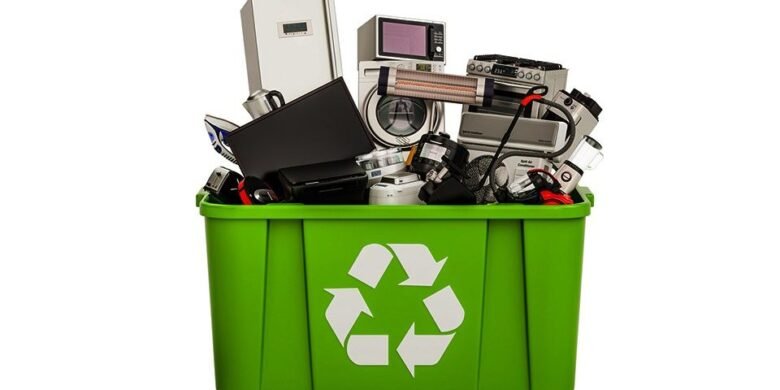In today’s digital world, technology is evolving faster than ever. New smartphones, laptops, and other electronic gadgets appear every year, luring consumers to upgrade. This constant innovation is great for convenience and progress, but it can also cause a huge environmental problem known as electronic waste, or e-waste. Electronic waste includes old electronics such as computers, telephones, televisions, and household appliances. The amount of waste generated by gadgets is increasing as the number of devices increases. The environment is at risk from improper disposal of eWaste, since these devices contain hazardous materials such as lead, mercury, and cadmium. E-waste recycling is dependent on how individuals, businesses, and societies address this growing problem and identify more sustainable solutions.
The Global E-Waste Problem
Electronic waste is among the fastest-growing waste streams around the globe. Global estimates show that millions of tons of electronic waste are produced annually. However, only a small portion of this waste is recycled. Much of the e-waste ends up in landfills or is shipped to developing nations, where it is often dismantled manually in unsafe conditions. Electronic devices contain toxic materials that can pollute soil and water. This debris is harmful to both humans and the environment. E-waste also contains valuable materials like gold, copper, silver, and rare earth metals, which could be recovered and repurposed. Unfortunately, improper disposal of these items results in the permanent loss of these valuable resources. E-waste recycling depends on effective methods to collect, reuse, and process these materials while minimizing harm to the environment.
Innovative Technological Solutions for E-Waste Recycling
The technology itself provides new solutions to the problem of e-waste. Modern recycling techniques are more sophisticated, using robotics and artificial intelligence to separate valuable materials out of discarded electronics. Machines are being developed that will efficiently disassemble electronics and extract metals, without exposing people to toxic substances. Robotic disassemblers can be used to remove screens, batteries, and other internal components of old computers and smartphones in seconds. These innovations increase recycling efficiency and reduce environmental hazards. Future recycling facilities will likely use smart technology to track and manage e-waste better so that less material goes to waste and more is repurposed into new products.
Consumer Awareness and Behavioral Change
Although governments and corporations play a major role in the growing problem of e-waste, it is also up to consumers to take responsibility. Many people throw old gadgets away without considering their impact on the environment. It is important to increase awareness of recycling and responsible disposal. By choosing to recycle old devices, donate to refurbishing programs, or participate in take-back programs, consumers can reduce overall waste. Public participation and education are key to the future of e-waste recycling. Social media, school programs, and awareness campaigns help people to understand how to manage their electronic waste responsibly. Recycling rates will increase as more people become aware of the impact their gadgets have on the environment.
Designing Gadgets to Sustain Sustainability
Designing electronics that are more durable and easier to recycle and repair is one of the best ways to reduce electronic waste. In the past, devices were designed with planned obsolescence, which means they were deliberately made to quickly become outdated. This practice leads to increased sales but also massive waste. However, the future of gadget design is moving towards sustainability. Now, companies are focusing more on modular devices that have replaceable components, recyclable materials, and durable construction. Laptops with frameworks, for instance, let users easily replace or upgrade parts, which extends the lifespan of the product. Smartphones with replaceable screens and batteries are also becoming more popular. This new design philosophy encourages repairability and reuse, opening the door to a circular economy.
Recycling Precious Metals and Rare Materials
It is surprising how many valuable minerals and metals are found in old electronics. Circuit boards and components are full of valuable materials such as gold, silver, palladium, copper, and more. The earth’s resources are expensive and damaging to the environment, but recovering these materials from e-waste can be a more sustainable option. Future recycling technologies will concentrate on enhancing the recovery rate of these rare materials using advanced chemical or mechanical processes. Some companies are testing eco-friendly methods of extraction that require minimal energy and chemicals. Efficient metal recovery reduces not only the need for mining but also greenhouse gas emissions. E-waste recycling is set to become profitable and environmentally friendly as these technologies advance.
Artificial Intelligence and Waste Management
Artificial intelligence and data analysis will play a significant role in the future of electronic waste recycling. AI can identify, sort, and process waste more accurately and efficiently. Machine learning algorithms are able to predict recycling requirements, track materials throughout their lifecycle, and optimize resource recovery. AI systems, for example, can identify valuable components within discarded devices and reduce the amount of waste. These intelligent systems can assist recycling centers and governments in managing e-waste flows and detecting illegal dumping activities. AI will help recycling operations become more sustainable and intelligent. They can also manage the growing global electronics waste volume.
Conclusion
If we combine technology with responsibility and cooperation, recycling e-waste, old gadgets, and other electronic waste will become a reality in the future. The importance of managing electronics’ end-of-life impact is increasing as the demand for electronic devices continues to increase. The tech industry is moving toward a sustainable model with advancements in recycling technologies, stronger government policies, and greater corporate social responsibility. The consumers also play an important role in promoting eco-friendly practices and making conscious choices. E-waste can be transformed from an environmental menace into an opportunity to progress by embracing a sustainable circular economy. Recycling has a promising future, but we need a global commitment to ensure that technology serves humanity without destroying the planet.
FAQs
1. What is electronic waste?
Electronic waste is a term used to describe discarded devices, such as smartphones, computers, televisions, and household appliances, that have either reached their end-of-life or are no longer being used.
2. Why is it important to recycle e-waste?
Recycling e-waste contributes to environmental protection by preventing the release of harmful materials like lead, mercury, and cadmium into the air. It also allows for valuable metals such as gold, copper, and silver to be recovered and reused.
3. How can old gadgets be recycled?
You can recycle your old electronic devices at authorized recycling centers or participate in trade-in programs with companies.
4. What are tech companies doing to reduce electronic waste?
Tech companies design sustainable products using recycled materials and invest in advanced recycling technologies to reduce waste.
5. What is the future for e-waste recycling?
The future of e-waste recycling lies in automation, AI-driven systems, eco-friendly materials recovery, and global collaboration to create a circular and sustainable tech economy.




